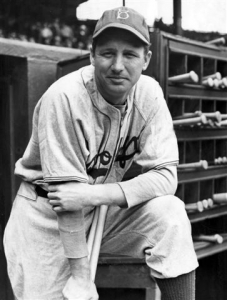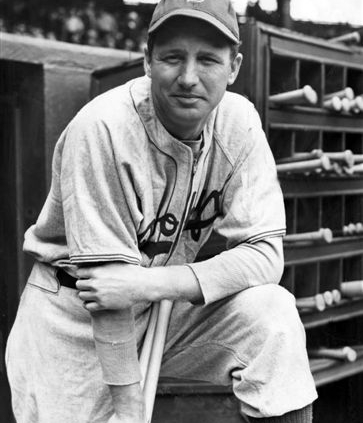September 2, 1944: Dixie Walker hits for the cycle as Dodgers climb out of last place
 The 1944 Brooklyn Dodgers were struggling. They played .167 baseball in July, winning just five of 30 games. They had completed a 20-game road trip from August 9 to 27. After winning the first three games against the Chicago Cubs, they went 3-14, including losing both ends of three doubleheaders, and they dropped into last place in the National League, 45 games behind the St. Louis Cardinals. Now that the dreadful road trip was over, the Dodgers had won their first three home games back at Ebbets Field.
The 1944 Brooklyn Dodgers were struggling. They played .167 baseball in July, winning just five of 30 games. They had completed a 20-game road trip from August 9 to 27. After winning the first three games against the Chicago Cubs, they went 3-14, including losing both ends of three doubleheaders, and they dropped into last place in the National League, 45 games behind the St. Louis Cardinals. Now that the dreadful road trip was over, the Dodgers had won their first three home games back at Ebbets Field.
A modest crowd of 12,441 showed up on Saturday, September 2, to see the Dodgers compete with their rivals, the New York Giants. The Giants had also played on the road for 17 games in mid-August, losing 13 straight before winning the final three. The Giants had gone 4-3 since, and they came into Brooklyn in fourth place in the NL standings, 10 games ahead of the Dodgers.
Right-hander Curt Davis started for Brooklyn. He was five days shy of his 41st birthday and had been used as both a starter and reliever by manager Leo Durocher. Bill Voiselle did the twirling for the Giants. The 25-year-old righty had been called up in each September of the previous two seasons, making only six total appearances. In 1944, his first full season with New York, he made 43 total appearances, and he led the American League in games started (41), innings pitched (312⅔), home runs allowed (31), and strikeouts (161). Before this game, he had beaten the Dodgers five times in six starts.1
The Dodgers began clubbing Voiselle in the bottom of the first inning. Frenchy Bordagaray started things with a single. Voiselle, in an attempt to pick him off, threw the ball away for an error, and Bordagaray scampered to second. Augie Galan walked, and then Dixie Walker poked an RBI single, plating Bordagaray with the game’s first run. An inning later, Tommy Brown walked with one away. Davis sacrificed him to second, and Brown scored when Bordagaray grounded a ball to third. Third baseman Nap Reyes fielded the ball and threw the ball past first baseman Phil Weintraub for the second error in as many innings. Brown scored and Bordagaray again scampered to second. After two innings, New York had made two costly errors and Brooklyn had a 2-0 lead.
In the third, “Brooklyn fell on Bill Voiselle with wild Neanderthal cries and chased him” from the field. Walker led off with a home run that “cleared the right field wall and went on into Bedford Avenue through an opening in the screen.”2 The ball had not gone over the screen; it had gone through it! Luis Olmo and Howie Schultz then hit back-to-back doubles, and New York player-manager Mel Ott pulled Voiselle. Rookie Jack Brewer came out of the bullpen in relief. Eddie Stanky sacrificed Schultz to third before Brown grounded out. Then, with Davis batting, Schultz attempted to steal home and was tagged out, but the Dodgers had doubled their advantage.
Davis had been tagged for three singles in the first three innings, but with one out in the top of the fourth, Ott “doubled to left and gimped home on Weintraub’s triple off the center field wall.”3 Weintraub’s three-bagger came a great price, though. He jammed his ankle at third base and had to be carried off of the field on a stretcher.4 Hal Luby ran for Weintraub. (He later played third base and Reyes moved from third to first.) An out later, Buddy Kerr bashed a double, scoring Luby. Reyes was intentionally walked, bringing up the pitcher. Ott sent Billy Jurges in as a pinch-hitter for Brewer, and Jurges produced, driving in the third New York run of the inning with a single.
The Giants had made the game close, bringing them within a run of the Dodgers, but Brooklyn “stepped right out again and fattened their advantage with three runs in their fourth.”5 Ace Adams became the third New York pitcher, and he quickly retired the first two batters he faced. Then, however, he lost some control and walked both Mickey Owen and Galan, bringing up the hot-hitting Walker, who drove an Adams offering to the center field exit gate. The ball bounced off the screen and Walker made it to third base with a triple. Olmo singled in Walker, and suddenly the Dodgers had those three runs back.
Stanky led off the home half of the fifth with a walk. Brown bunted him to second, and Bordagaray brought him home with his third single of the afternoon. The Dodgers had “scored steadily for the first five innings,”6 and now led the Giants, 8-3.
Davis yielded a pair of two-baggers to Kerr and Johnny Rucker in the sixth. Rucker’s “towering shot hit the top rail of the high screen but instead of going on over bounced back on the field, so Johnny was held to a double.”7 Kerr had scored but Rucker was stranded, and the Giants still trailed by four runs.
The game settled down. Walker hit a one-out double in the bottom of the sixth (his 30th double of the season), but his teammates could not bring him home, and the Dodgers did not muster any more threats. On the mound, Davis was touched for four more hits through the final three innings, but New York could not cross the plate with a runner. Behind Davis’s complete game, Brooklyn had won 8-4. The Dodgers ran their modest winning streak to four games and lifted themselves out of the National League basement.
Davis, dubbed “Ol’ Dan’l Boone,”8 allowed 14 hits to the Giants, three more than all five of the New York hurlers combined. The difference was that Davis “tighten[ed] up in the pinches to leave [11] Giant runners stranded on the bases.”9 The Dodgers left only seven men on base. Bordagaray had another single to open the eighth and finished the game with a 4-for-5 day at the plate (all singles). For the Giants, Kerr was 3-for-4 with two doubles and two runs scored.
In the Brooklyn victory, “the people’s choice [Walker] belted a single, double, triple and home run for a perfect day.”10 He had driven in four runs and scored two. He raised his average 6 points to .361 and his on-base plus slugging percentage (OPS) to .980. Dixie Walker became the fifth Brooklyn franchise batter to hit for the cycle, joining Oyster Burns (August 1, 1890, against the Pittsburgh Alleghenys), Jimmy Johnston (May 25, 1922, against the Philadelphia Phillies), and Babe Herman (who hit for the cycle twice – on May 18, 1931, against the Cincinnati Reds and again on July 24, 1931, against the Pittsburgh Pirates).
Walker’s accomplishment of the rare event was the third cycle of the 1944 season, coming after two Boston Red Sox players: Bobby Doerr‘s cycle on May 17 (against the St. Louis Browns)11 and Bob Johnson‘s cycle on July 6 (against the Detroit Tigers).
For the month of September, the two teams headed in opposite directions. Brooklyn won 14 and lost 14. This game was a high point for the Dodgers and especially for Walker, who led the National League in batting average with a .357 mark. Meanwhile, New York lost 18 of 27 contests, including 15 of its final 19 games of the season. After Walker’s star turn, the Giants lost the next game to the Dodgers, too, but for the season, New York had the edge, taking 12 of 22 in the rivalry series. Despite the loss, Mel Ott remained on the field after the game, as he “spent ten minutes giving autographs to a group of wounded soldiers who saw the game.”12
SOURCES
In addition to the sources mentioned in the Notes, the author consulted baseball-reference.com, MLB.com, Retrosheet.org and SABR.org.
https://www.baseball-reference.com/boxes/BRO/BRO194409020.shtml
https://www.retrosheet.org/boxesetc/1944/B09020BRO1944.htm
Photo credit: Dixie Walker, National Baseball Hall of Fame Library.
NOTES
1 Voiselle’s loss to the Dodgers came in a night game played on May 23 at Ebbets Field. According to the Brooklyn Eagle, “there was a great confusion in the Giant outfield over a fly ball that fell safe, allowing two Dodgers runners to score the winning runs with two out in the ninth inning.” In reality, an error had been charged to Johnny Rucker, making both runs unearned. See Harold C. Burr, “Dodgers Rout Giants, 8-4, as Walker Stars,” Brooklyn Eagle, September 3, 1944: 15.
2 Roscoe McGowen, “Walker’s 4 Blows Help Dodgers Trim Giants Again, 8 to 4,” New York Times, September 3, 1944: S1.
3 Hy Turkin, “Walker Clouts for Cycle as Dodgers Rap Giants, 8-4,” New York Daily News, September 3, 1944: 48.
4 The papers reported that the x-rays revealed no break, but Weintraub did have a bad sprain.
5 Turkin.
6 Burr.
7 McGowen.
8 McGowen.
9 “Walker Glitters in Brooklyn Win,” Rochester (New York) Democrat and Chronicle, September 3, 1944: 16.
10 McGowen.
11 This was Doerr’s first time hitting for the cycle. His second time came on May 13, 1947, against the Chicago White Sox.
12 Burr.
Additional Stats
Brooklyn Dodgers 8
New York Giants 4
Ebbets Field
Brooklyn, NY
Box Score + PBP:
Corrections? Additions?
If you can help us improve this game story, contact us.


